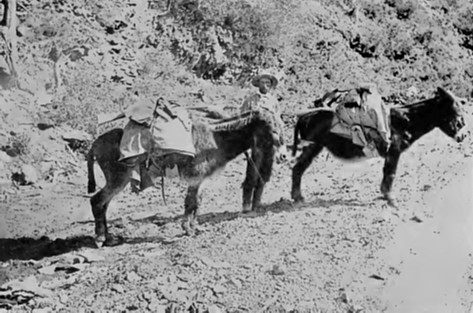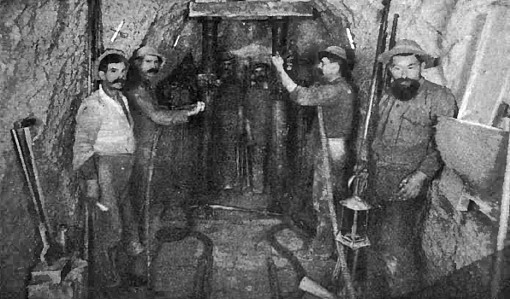There can be no doubt whatever, that at the present time the thousands of people in the Eastern States who are watching with eager eyes the developments in the Colorado mines, and as soon as the warm weather comes these capitalists and laborers will go in throngs to the mining camps which offer the best prospects for wealth. The fact that some of the camps have been overdone is both an advantage and a detriment to Cripple Creek. It is a detriment because it shows how possible it is to make a great deal of smoke from little Ham reputation on the product of a single mine, and to draw immense crowds on very slender foundation. It is an advantage, because it has removed from Cripple Creek some of its strongest rivals to public attention and popular favor. For the next few weeks Cripple Creek will be the center of attraction. It will receive more attention than any other new camp, more than most old ones. It will be most carefully scrutinized, it will be criticized, it will be extravagantly praised, and bitterly blamed. At the end of two or three months the leaders of public opinion will have made up their minds about the new mines, and as that opinion is bound to be distinctly favorable, there will follow the greatest rush to the mines that has ever been known in the history of the State, the early days of Leadville not excepted. The next few weeks will be the period of examination, after that will come the marvelous growth.
For this period of scrutiny, Cripple Creek is now in good condition. The thing that makes a mining district is the mines. It does not make any difference how many people there are at Fremont, or what town lots are worth there or at Lawrence, or even what mining stocks are worth in Colorado Springs. The thing that counts is the mines and the ore that is being taken out of them. During the past week a representative of the Gazette was in the district. His report consists not of his own opinions, but of facts, things which he saw, and the opinions of some of the best mining experts in the country. He visited every accessible mine in the district. Nearly every one of them is working two or three shifts of men. That is the best fact that has been recorded about Cripple Creek.
Another fact is, that every man who wishes to work can find employment. Wages have risen, and there are no idle men in Fremont, except those who are idle from choice. A most significant fact is that the tunnels and shafts are being permanently timbered. There is evidence that the owners of the mines are not only satisfied that they have considerable gold ore, and are willing to put up the money to prove it, but they also expect to keep on taking out ore for a long time to come, and are making arrangements for it now. In short, at the time when it can most readily draw the attention of the State and of the whole country, Cripple Creek finds itself not at the end of a wave of prosperity, but at its beginning; not with an overinflated gold rush real estate boom dragging it down, but with the mining I eat far in the ascendant; with more people going in than are coming out; with a winter well past, and a summer well begun: with a proportion between honest, hard work and speculation that is remarkable for a new camp, and would not discredit any of any age.
The Buena Vista Mining
Company.
The Buena Vista mine is situated on Bull Mountain, west of Grassy Gulch. It
was discovered in July, 1891, by Mr. Dougherty, prospector, who had recently
started in the new camp. He found a small vein two or three inches in the
porphyry. Sinking on this, it opened up, until at twelve or fifteen feet he
had a vein of from four to five inches in width. The value of the vein
matter was sufficient to warrant further development. Dougherty, not having
sufficient funds to develop the property, took in as partners Steven Blair
and William Steele, giving them a half interest for sinking the shaft to a
depth of thirty-five feet. When the shaft had been sunk to this depth,
Messrs. Pourtales and Parrish, who were looking over the camp for
investment, arrived at the Buena Vista, and were particularly pleased with
the appearance of things. Mr. Parrish had had a large experience in mining,
and thought the chances for a good mine were here. However, to make
assurance doubly sure, the services of Mr. Newberry, of Aspen, were engaged,
and, in
company with Messrs. Pourtales and Parrish, he made a trip to the camp, and
examined the Buena Vista. His opinion coincided so thoroughly with Mr.
Parrish's as to the value of the property that a bond and lease were at once
made, and a contract let to sink the shaft to a depth of seventy-five feet.
The result of this forty feet of sinking was the shipment of a car-load, of eighteen tons, of ore to the Omaha and Grant Smelting and Refining Company, in Denver. The first real mill run from the property gave a net return of over $120 per ton. A few more feet were sunk on the shaft, when levels were started north and south, developing a large vein of ore, averaging over $100 per ton. The levels are about fifty feet in length. The shaft is being sunk, and at this time has reached a depth of 130 feet. At the bottom of the shaft the vein is three feet wide, and gives an average assay of about $100 per ton. Assorted samples from the vein have given as high as $500. The net result of this dead work, including the sinking of the first forty feet of the shaft in the bond and lease, has been a surplus of about $2,000 over and above the expenses of development. The fissure is filled with quartz, and is from two to three feet in width. It has been steadily increasing in size, since the shaft was thirty-five feet deep. The country rock is porphyry, which is impregnated with value chiefly in the seams. The country rock from the shaft and levels has an average value of over 825 per ton, while assorted samples have run as high as $800 to the ton. The value in the vein consists of about sixty per cent, of free gold, the balance being divided between calaverite telluride of gold and iron pyrite.
The Calumet Mining and
Milling Co.
The " Morning Star" and "Burns" lodes were located in August, 1891, by
Patrick Burns, an old and well-known prospector. Later on, Mr. John J.
Mullin, the present manager, bought a half interest in the mines, and they
were then worked by the firm of Mullin & Bro. In January, 1892, the Calumet
Mining and Milling Company was organized, and purchased the properties, from
the firm. The officers of the Company are: President, Major John Hulbert, a
well-known mining man, and President of the Pike's Peak Cog Road; Vice
President, Mr. W. Putnam Page, a well -known business man of Boston,
Massachusetts; Secretary and Treasurer, Mr. Robt. D. Weir, senior member of
Weir & Rupp, Manitou; and Manager, Mr. John. J. Mullin. one of the earliest
to come into the camp, and a man of well-known business capacity, energy,
and fitness. The capital stock of the Company is 8700,000, fully paid, and
the shares are non-assessable. Of this amount, 8300,000 constitute the
treasury stock. The object of this Company is to operate the mines of the
Calumet Mining and Milling Company, in the Cripple Creek mining district.
Their property consists of the Morning Star and the Burns lodes, situate and
described as follows: The Morning Star is on the east slope of Bull
Mountain, and is then of the famous Buena Vista mine, which was surveyed
along the vein which runs through the Morning Star. At a depth of fifty
feet, and ore will soon be shipped. The Burns lode is nearer the top of Bull
Mountain, and lies joining the Pharmacist lode on the east.
Return
to The Colorado History Page:
Colorado Gold Rush History


